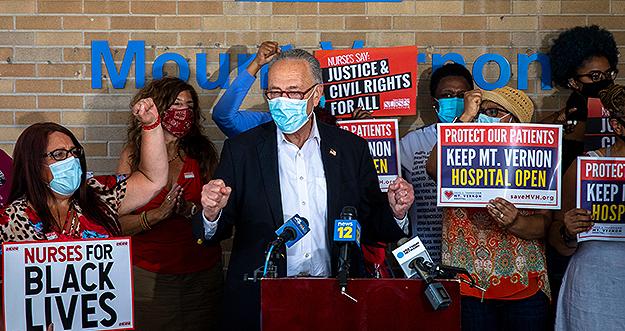SAVING Mount Vernon Hospital

Just weeks after COVID-19 peaked in Westchester County all signs indicated Montefiore Medical System was moving forward with plans to shutter Mount Vernon Hospital (MVH). Some 1,400 COVID-related deaths county-wide had not been persuasive. The ICU was now on the chopping block and 16 nurses were to be laid off. The nurses learned the news on Facebook.
This was a particularly devastating blow to a community hit hard by COVID. There were 2,700 cases in Mount Vernon alone, and Mount Vernon Hospital was the area’s only full-service facility.
The nurses at MVH responded swiftly with strong support from the community. On July 8, a car caravan and rally sounded the cry to #SaveMVH with State Senator Alessandra Biaggi and NYSNA-endorsed Democratic nominee for Congress, Jamaal Bowman, committed to attend.
Undermining a vulnerable community
Montefiore had announced its pending shutdown in October 2019, facilitated by $41 million from the NYS Department of Health. In the wake of COVID, staff and the public – who had not been consulted about the MVH closure—were hoping for a sea change. Instead, Montefiore has left them wondering: who will tend to the health of the community? Where will patients go if COVID makes a comeback?
“They are not treating us fairly, not treating the community fairly. We need justice,” said Mount Vernon ICU nurse Kameisha Brown.
Mount Vernon is a dense community with 70,000 residents, 65% percent of whom are Black and 16.5% Latino, a majority-minority community, especially vulnerable to the threat of COVID. Nearly 15 percent of all residents live in poverty. Mortality rates in the black community are high.
Montefiore is seemingly indifferent to the challenges of a community already battling for better health, and has offered as an alternative to MVH an off-campus Emergency Department.
The undermining of public health began in Mount Vernon in 2017, when the Bronx-based Montefiore acquired MVH, and initiated a prolonged campaign to take apart the hospital.
Montefiore's broken promises
Thirty years ago, MVH was a full-service hospital, Med-Surg nurse Bernetta Urquhart said. “Obstetrics, cardiology, pediatrics, oncology, we had it all. You name it, we had it. But over the years, I’ve seen all the services stripped away.”
“When Montefiore took over,” said Urquhart, “they promised to bring specialists and diagnostics to the hospital to make MVH more feasible and tempting for the community. But all they did was change some light bulbs, make some small changes, that kind of thing. They did not embrace us.” What’s more, said Urquhart, “if Mount Vernon patients need to be transferred to more specialized care, Montefiore often doesn’t accept their insurance.”
Sacrificing patient safety
Montefiore claims the ICU closure is a result of “underutilization” by the community.
The lack of investment made “underutilization” a self-fulfilling prophecy. The health needs in the Mount Vernon community haven’t gone away. It’s quite the opposite—they’ve increased.
With the ICU shuttered, any patient needing surgery or admission will have to go to Montefiore New Rochelle, three and a half miles away. “By the time a patient gets to New Rochelle, they could bleed out or have a cardiac arrest,” explained Urquhart. “The time is a big issue. This change is not about the umbrella of ‘do no harm,’ patient safety first. It’s about money.”
“Some of our patients need dialysis, have diabetes, or need cardiac care, and are emergency cases,” added Brown. “The ICU is essential to the community.”
Winning progress against closure plans
The community needs and deserves a fully functioning hospital. That means restoring already-closed units, implementing safe staffing, and making meaningful and sustained investment in MVH.
Two days after NYSNA’s first rally, Montefiore agreed to rescind the layoffs of the 16 nurses. Having successfully beaten back the layoffs, nurses and supporters held another rally. On July 19, U.S. Senate Minority Leader Chuck Schumer and NYS Senator Jamaal T. Bailey spoke outside MVH. Stalwart supporters Alessandra Biaggi and Jamaal Bowman were also there.
“In the face of the greatest public health crisis we’ve had in 100 years, where it has deeply impacted the Black community, you do not close down hospitals and restrict access to healthcare,” said Senator Schumer.
Closures are a statewide crisis
Montefiore said it was reconsidering the ICU closure, though nothing official has been announced.
Without a doubt, reversing the layoffs and potentially halting the ICU closure are wins. But Mount Vernon nurses know that they need to press on. Their slogan—“save MVH”—now includes “transform MVH”.
The campaign to save MVH is part of a larger effort against closures. In New York City, as a result of dozens of mergers and closures in New York City in the past decade, the outer boroughs that saw the most coronavirus cases also had the least bed capacity. While Manhattan has 5 hospital beds per 1,000 patients, there are only 1.8 per 1,000 residents in Queens, 2.2 in Brooklyn and 2.4 in the Bronx.
It’s part of a plan around boosting revenue at rich hospital systems. When the richer hospital systems consolidate to make more money, they leave struggling safety net and public hospitals to care for low-income patients. The areas abandoned by wealthy hospital systems include low-income communities of color, like Mount Vernon. When Medicaid dollars are reduced, there is even greater incentive for hospital systems to close community hospitals, dumping low-income patients from their portfolios. The result: so-called “healthcare deserts.”
Moratorium on closure and more
The progress in stopping the RN lay-offs and impeding the ICU closure at Mount Vernon demonstrates how nurses joined by community advocates have the power to protect critical healthcare services.
What’s next? Nurses see that a moratorium on hospital closures must be passed on the state level, as well as reversing cuts to Medicaid. Ultimately, a single-payer system will alter the dynamics away from a profit-making system to one all about patient care. Whenever a unit or hospital is threatened with closure, nurses, coworkers, the community, and allies banded together can turn the tide.